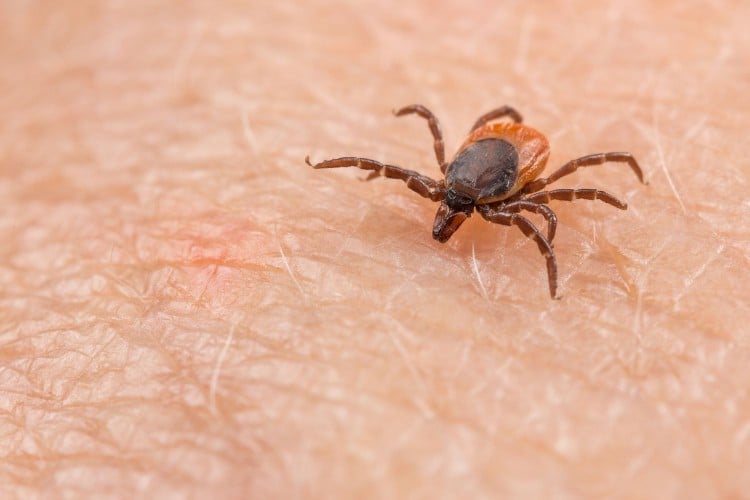What Is Rocky Mountain Spotted Fever? CDC Issues Health Alert
- The CDC issued a health alert for Rocky Mountain spotted fever (RMSF), a tickborne illness, after five people were hospitalized and three died of the disease.
- Those infected had all recently been to northern Mexico.
- Experts recommend people seek medical attention promptly if they've been bitten by a tick, and have a rash or other symptoms of RMSF.
Three people have died after contracting Rocky Mountain spotted fever (RMSF), the Centers for Disease Control and Prevention (CDC) said.
In a health alert posted last week, the agency outlined five cases of the tickborne illness that were reported between July and December of this year.
Four of the five infections were in kids under the age of 18, all of whom had traveled to or had a residence in Tecate, Mexico, in the two weeks before becoming sick.
The CDC warned that RMSF is “a severe, rapidly progressive, and often deadly disease,” and is spread by infected ticks. All five of the patients included in the agency’s health alert were hospitalized; three later died.
While the U.S. sees thousands of cases of RMSF each year, the fact that these cases are so concentrated is likely a cause for added concern, Kari Simonsen, MD, MBA, a professor of pediatric infectious diseases at the University of Nebraska Medical Center, told Health.
“I have a feeling that the CDC wanted to make sure people were alerted because there was more of a clustering geographically,” she said. “There may be a bit more Rocky Mountain spotted fever being carried by ticks in that area right now.”
In addition to warning residents or travelers to Tecate about the risk of RMSF, the CDC's alert is also intended to encourage healthcare providers to be on the lookout for the disease, particularly if they’re seeing patients with unexplained severe symptoms, Ann Carpenter, DVM, MPH, an epidemic intelligence service officer in CDC’s Rickettsial Zoonoses Branch, told Health.
Here’s what you need to know about the CDC’s warning, how to spot RMSF, and tips for avoiding the disease.

Getty Images / Ladislav Kubeš
Rocky Mountain Spotted Fever Often Includes a Rash
Rocky Mountain spotted fever—similar to Lyme disease—is caused by bacteria that are passed from ticks to humans from a bite, Simonset explained.
The illness is caused by the bacteria Rickettsia rickettsii, which can infect several different species of tick.
In most of the contiguous U.S., RMSF is transmitted by the American dog tick or the wood tick, Carpenter said.
Spotted fever rickettsiosis—an umbrella term that includes RMSF and a few other diseases—is most common in Arkansas, Missouri, North Carolina, Tennessee, Virginia, and surrounding states.
“It’s sort of the southern Appalachian region, rather than the Rockies. So it feels like a little bit of a misnomer,” said Simonsen. “But there are cases reported really from east to west.”
In the southwestern United States and northern Mexico, Rickettsia rickettsii bacteria are transmitted by the brown dog tick.
Simonsen explained that northern Mexico, particularly, has seen more RMSF cases in recent years.
“Unlike in most of the United States, northern Mexico has a comparatively high incidence of disease, particularly in urban centers in multiple states where RMSF is transmitted by the brown dog tick,” Carpenter told Health.
In this case, ticks will move from dogs to humans—the CDC noted that most spotted fever cases “occurred within communities with large numbers of free-roaming dogs.”
Once a person is bitten by an infected tick, the disease can progress rapidly, with symptoms including:
- Fever
- Headache
- Nausea
- Abdominal pain
- Vomiting
- Joint and muscle aches
- Rash
“Spotted fever, of course, is indicative of the rash,” said Simonsen. “It tends to start on the extremities, and really on the ankles and the wrists. And that’s not that common for a lot of other types of rashes from an infection.”
Over time, that rash moves closer to the trunk of the body, she explained.
The rash itself—which appears like tiny scabs—also tends to change as the infection intensifies. At first, the lesions are faint and appear to go away when a person applies pressure, Simonsen said. Over time, the color won’t change with pressure.
Symptoms are often mild for a few days but can progress rapidly around the fifth day of illness. In these advanced stages, the RMSF infection can lead to coma, tissue death, multiorgan system damage, brain swelling, or altered mental status.
Children, Simonsen said, are at a higher risk for this rapid RMSF progression.
Kids younger than 10 are “five times more likely than adults to die from RMSF,” Carpenter added.
11 Tick-Borne Diseases You Need To Know About
RMSF Can Be Treated, But Prevention Is Key
Because RSMF can be so dangerous, it’s important to recognize signs of the illness. The most obvious sign is often the rash, as well as any noticeable tick bites.
However, it’s not always so simple.
Not all people with RMSF develop the classic spotted rash, and many people may not even notice that they’ve been bitten, Carpenter explained.
Additionally, other RMSF symptoms can be “relatively mild and non-specific early during the course of illness,” she said.
But even if someone is experiencing more mild symptoms, it’s important to seek treatment if someone seems wrong, as getting treatment early is critical.
“The disease progresses rapidly if left untreated and is frequently deadly unless treated with doxycycline within the first 5 days of illness,” said Carpenter. “If RMSF is suspected, health care providers should initiate treatment with doxycycline immediately.”
Of course, the best thing to do is avoid RMSF in general—this means avoiding tick bites.
“If you’ve been outside, hiking around, or even just playing in the yard, look for ticks on yourself, and also on kids when they come in from outside,” said Simonsen.
Ticks often move to body creases or the hair since there’s a smaller chance of them being discovered, she added, so it’s worth being thorough.
“Also check your pet for ticks, especially after they spend time outdoors,” Carpenter recommended. “Run your fingers through your pet’s fur with gentle pressure to feel for any small bumps.”
People should also keep up with tick-prevention medications for their dogs, she said.
For humans, using bug spray and wearing protective clothing—such as boots and longer socks if you’re hiking—will help avoid any tick bites, Simonsen said.
Do Tick Bites Cause a Red Meat Allergy? What to Know About The Rise of Alpha Gal Syndrome










